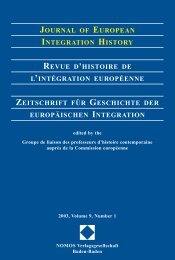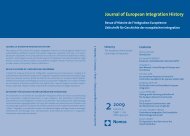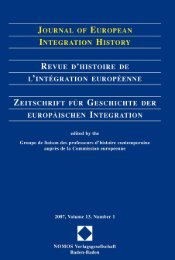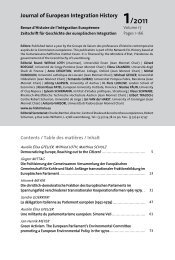journal of european integration history revue d'histoire de l ...
journal of european integration history revue d'histoire de l ...
journal of european integration history revue d'histoire de l ...
You also want an ePaper? Increase the reach of your titles
YUMPU automatically turns print PDFs into web optimized ePapers that Google loves.
From Isolation to the Core: Finland's Position towards European Integration 69<br />
The collapse <strong>of</strong> the Soviet Union, finally, brougt about a pr<strong>of</strong>ound change in<br />
Finland's international position. In early 1992 a new Basic Agreement between Finland<br />
and the Russian Fe<strong>de</strong>ration replaced the FCA Pact, which meant that Finland's<br />
international action was freed from Moscow’s control. Once the 1947 Finnish-Soviet<br />
tra<strong>de</strong> agreement was replaced by a new one and the 1960 tariff agreement abolished,<br />
Finland freed herself from those obligations in the field <strong>of</strong> foreign tra<strong>de</strong> that<br />
were incompatible with the common tra<strong>de</strong> policy <strong>of</strong> the EC. 28 These contractual<br />
changes, at least, removed obstacles for Finland's policy with regard to West European<br />
<strong>integration</strong>. Later the same year 1992, the very concept <strong>of</strong> “neutrality” was re<strong>de</strong>fined<br />
to mean “military non-alignment” and “in<strong>de</strong>pen<strong>de</strong>nt <strong>de</strong>fence” as forms <strong>of</strong><br />
characterisation <strong>of</strong> Finland's foreign policy. 29<br />
The failed coup in Moscow, August 1991, was the turning point on Finland's<br />
way to EC membership. Obviously, security policy consi<strong>de</strong>rations in the shadow <strong>of</strong><br />
the Russian turmoil were <strong>de</strong>cisive for the rapid turn in the Finnish opinion, while<br />
the EEA negotiations still were going on. 30 The Social Democratic Party stood up<br />
for membership, and in the autumn <strong>of</strong> 1991 both the Coalition Party and the Social<br />
Democratic Party urged the government to hasten preparations for membership.<br />
The fourth government report to Parliament on Finland's relationship with West<br />
European <strong>integration</strong>, January 1992, already advocated EC membership. In March<br />
1992 the Finnish Parliament, finally, voted 133 to 60 in favour <strong>of</strong> an application for<br />
EC membership. The Finnish application, which did not inclu<strong>de</strong> any reservations,<br />
was submitted to Brussels on 18 March 1992.<br />
The Central Union <strong>of</strong> Agricultural Producers – among interest organisations –<br />
and the Christian Union – among political parties- were then and still remain today<br />
the most violent opponents to EC/EU membership. Taking a <strong>de</strong>cision on EC membership<br />
was most difficult for the Center Party. A majority <strong>of</strong> the party supporters,<br />
mainly farmers and other rural people, was against membership, but the party was,<br />
from April 1991, the leading government-coalition partner and could not afford a<br />
government crisis. Therefore in early 1992 the party lea<strong>de</strong>rship arranged a series <strong>of</strong><br />
provincial meetings through which the party folk reluctantly authorised the lea<strong>de</strong>rship<br />
to act in favour <strong>of</strong> EC membership. 31<br />
Negotiations with the Commission exten<strong>de</strong>d over a year from the spring <strong>of</strong> 1993, simultaneously<br />
with other applicant countries. In the referendum <strong>of</strong> 16 October 1994,<br />
membership was approved to by 57 against 43 percent, i.e. with a larger majority than<br />
in Swe<strong>de</strong>n. In the succeeding Parliamentary vote, the membership option won 152 to<br />
45. Over half <strong>of</strong> the opposition votes came from the Center Party, even though a scarce<br />
27. e.g. E. ANTOLA, From Bridge-Building to Broker, op.cit., pp.19-22.<br />
28. Suomen säädöskokoelman sopimussarja – Finlands författningssamlings fördragsserie, No.63/<br />
1992, ibid., No.70/1992.<br />
29. e.g. E. ANTOLA, From Bridge-Building to Broker, op.cit., pp.28-33.<br />
30. See M. JAKOBSON, Finland in the New Europe, Westport, 1998, p.111; E. ANTOLA, From<br />
Bridge-Building to Broker, op.cit., pp.30-36.<br />
31. See e.g. O. SUNNARI, Suomen EY-liityntä poliittisena prosessina. Aineistoraportti, Turku, 1993,<br />
pp.39-66.

















